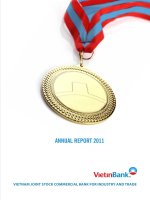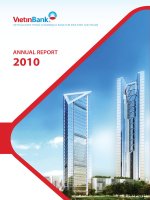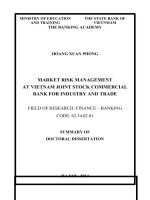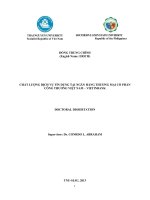Enhancing credit risk management in vietnam joint stock commercial bank for industry and trade – hoang mai branch,graduation thesis
Bạn đang xem bản rút gọn của tài liệu. Xem và tải ngay bản đầy đủ của tài liệu tại đây (635.89 KB, 76 trang )
THE STATE BANK OF VIETNAM
BANKING ACADEMY
FACULTY OF FOREIGN LANGUAGES
-----*****-----
GRADUATION THESIS
Topic: Enhancing Credit Risk Management in Vietnam Joint-stock
Commercial Bank for Industry and Trade – Hoang Mai Branch
Supervisor: MA. Ngo Tung Anh
Student: Nguyen Van Truong
Class: ATCB - K12
Major: English in Banking and Finance
Student Code: 12A7511194
Hanoi, May 2013
DEDICATION
This thesis is dedicated to my parents who have supported me since the
beginning of my study.
Also, this thesis is dedicated to the lecturers and students in faculty of foreign
languages.
Finally, this thesis is dedicated to Banking Academy of Vietnam.
ACKNOWLEDGEMENT
I would like to express my sincere gratitude to my supervisor Mr. Ngo Tung
Anh for his continuous support, patience, motivation, enthusiasm, useful comments
and remarks. Without his guidance and persistent help this thesis would not have been
possible.
I would like to give the deep appreciation to recruitment team of Vietnam jointstock commercial bank in Industry and Trade (Vietinbank) – Hoang Mai Branch for
considering my CV, interviewing and offering me an internship opportunity at the
branch.
In addition, I would like to thank the Non-performing Loan Recovery
Department Manager at Vietinbank Hoang Mai, Mr. Hoang Van Kiem, who has
introduced loan recovery operations to me as well as supported me during practical
loan recovery process.
Finally, I would like to thank all the lecturers and classmates at Banking
Academy for their dedication and support during the 4-year course.
Hanoi, May 28, 2013
ABSTRACT
After Vietnam joined World Trade Organization (WTO), banking and finance
industry in Vietnam is approaching many opportunities as well as facing many
challenges. Currently, the non-performing loan (NPL) ratio of commercial banks in
Vietnam in general and Vietnam Joint-stock Commercial Bank for Trade and Industry
(Vietinbank) in particular witnessed the signs of rising beyond the allowed rate under
the State Bank of Vietnam’s provisions. This does not only have influence on
commercial banks but also the national economy. However, commercial banks still
encounter difficulties in managing NPLs. This thesis is going to clarify some basic
issues about the theoretical basis in the credit risk management of commercial banks.
After analyzing business situation and credit risk management activities, some
measures will be discussed to improve the effectiveness of risk management in
Vietinbank.
TABLE OF CONTENTS
INTRODUCTION ........................................................................................................1
CHAPTER 1: THERORETICAL BACKGROUND OF CREDIT RISK
MANAGEMENT IN THE OPERATIONS OF COMMERCIAL BANKS ............4
1.1. Credit risk in the operations of commercial banks ..................................................4
1.1.1. The concept of risk and the credit risk .................................................................4
1.1.2. Classification of credit risk ...................................................................................5
1.1.3. Characteristics of credit risks ...............................................................................6
1.1.4 The main basis for determining the level of credit risk .........................................7
1.1.5. Consequences of credit risk ................................................................................11
1.1.6. Causes of the credit risk ......................................................................................12
1.2. Credit risk management .........................................................................................13
1.2.1. The necessity of the credit risk management .....................................................13
1.2.2. Mission of the credit risk management...............................................................14
1.2.3 Credit risk measurement: .....................................................................................14
1.3. Basel core principles of credit risk management ...................................................18
1.3.1. Introduction.........................................................................................................18
1.3.2. Basel core principles of credit risk management ................................................18
1.4. The application of credit risk management models in Vietnam’s commercial
banks .............................................................................................................................20
1.4.1. Credit appraisal ...................................................................................................20
1.4.2. Credit inspection .................................................................................................21
1.5. Conclusion .............................................................................................................22
CHAPTER 2: REALITY OF CREDIT RISK MANAGEMENT IN VIETNAM
JOINT-STOCK COMMERCIAL BANK FOR INDUSTRY AND TRADE –
HOANG MAI BRANCH ............................................................................................23
2.1. Overview of Vietnam Joint-stock Commercial Bank for Industry and Trade –
Hoang Mai Branch ........................................................................................................23
2.2. The organizational structure of Vietnam Joint-stock Commercial Bank for
Industry and Trade - Hoang Mai Branch ......................................................................24
2.2.1 The organizational model ....................................................................................24
2.2.2. Function and duty of departments at Vietnam Joint-stock Commercial Bank for
Industry and Trade - Hoang Mai Branch ......................................................................26
2.3. Reality of Credit Operation and Credit Risk Management in Vietnam joint-stock
commercial bank for Industry and Trade – Hoang Mai Branch ...................................31
2.3.1. Credit Operations ................................................................................................31
2.3.2. Reality and causes of credit risk: ........................................................................34
2.3.3. Reality of credit risk management ......................................................................38
2.4. Conclusion .............................................................................................................45
CHAPTER 3: MEASURES TO IMPROVE CREDIT RISK MANAGEMENT IN
VIETNAM JOINT-STOCK COMMERCIAL BANK FOR INDUSTRY AND
TRADE – HOANG MAI BRANCH..........................................................................46
3.1. Viewpoints of the Vietnam Joint-stock Commercial Bank for Industry and Trade
– Hoang Mai Branch on credit policy & credit risk management to 2015...................46
3.1.1. Viewpoints: .........................................................................................................46
3.1.2. Objectives ...........................................................................................................47
3.2. The measures to improve the quality of credit risk management in Vietnam Jointstock Commercial Bank for Industry and Trade – Hoang Mai Branch ........................48
3.2.1. Improving credit granting process ......................................................................48
3.2.2. Building effective credit policy ..........................................................................49
3.2.3. Improving credit information system .................................................................53
3.2.4. Credit risk prevention measures .........................................................................55
3.2.5. The solutions to reduce and offset losses when risks occur ...............................58
3.2.6. Human Resources Solutions ..............................................................................59
3.3. Other recommendations .........................................................................................60
3.3.1. Recommendations for the State Bank of Vietnam .............................................60
3.3.2. Recommendations for the Government of Vietnam ...........................................62
3.4. Conclusion .............................................................................................................63
RECAPITULATION AND CONCLUDING REMARKS......................................64
IMPLICATIONS ........................................................................................................65
LIMITATIONS OF THE THESIS ...........................................................................66
REFERENCES ...........................................................................................................67
TABLE OF ABBREVIATIONS
Abbreviations
Meaning
CIC
Credit Information Center
IT
Information Technology
NPL
Non-performing Loan
Vietinbank
Vietnam Joint-Stock Commercial Bank for Industry and Trade
SBV
The State Bank of Vietnam
SME
Small and Medium Enterperise
USD
U.S Dollar
VND
Vietnam Dong
WTO
World Trade Organization
LIST OF TABLES
Table 1: Total Outstanding Loans from 2009 to 03/2013 (Unit: Billion VND) ..........33
Table 2: Portfolio structure in terms of economic sector (Unit: billion VND) ............34
Table 3: Delinquency (unit: Billion VND) ...................................................................35
Table 4: Loan Classification from 2009 to 03/2013 (Unit: Billion VND) ...................36
Table 5: Customer Policy .............................................................................................51
LIST OF ILLUSTRATIONS
Diagram 1: Executive committee .................................................................................24
Diagram 2: Operation structure ....................................................................................25
Diagram 3: Credit granting process ..............................................................................41
Graduation Thesis
Banking Academy
INTRODUCTION
1. Rationale to the study
Credit is the most complex banking operation compared to other banking
operations. Inspite of the profits, this activity brings many risks. Therefore, credit risk
will not only impact directly to the existence and development of each credit
institution, but also affect the entire banking system and the whole economy. Credit
risk management is the difficult task but urgent, especially for commercial banks of
Vietnam as income from credit mainly accounts for 60-80% of banks’ income.
In the last quarter of 2012, the non-performing loan (NPL) ratio of commercial
banks in Vietnam in general and Vietnam Joint-stock Commercial Bank for Trade and
Industry (Vietinbank) in particular witnessed the signs of rising beyond the allowed
rate under the State Bank of Vietnam’s provisions. So what is the cause? How to
improve the quality of credit risk management in the credit operation of Vietinbank?
In this context, as a student studying at Banking Academy of Vietnam with the
encouragement of the faculty, I would boldly choose the subject "Enhancing credit
risk management in Vietnam Joint-stock Commercial Bank for Industry and Trade
– Hoang Mai Branch "as the thesis subject.
2. Objectives of the study
The thesis is going to resolve 3 main issues as follows:
-
Clarifying some basic issues about the theoretical basis in the credit risk
management of commercial banks.
-
Analyzing business situation and credit risk management activities in
Vietinbank, thereby giving the positives as well as the drawbacks of this
administration task.
Nguyen Van Truong
1
ATCB – K12
Graduation Thesis
-
Banking Academy
Proposing measures to improve the effectiveness of credit risk management
can be applied in practice to improve the effectiveness of risk management at
Vietinbank.
2. Subject and Scope of the study
-
Study Subject: Industrial and Commercial Bank of Vietnam – Hoang Mai
Branch.
-
Scope of study: Business Activity of Industrial and Commercial Bank of
Vietnam - Hoang Mai branch.
3. Study questions
-
What is the theoretical basis related to credit risk, credit risk management?
-
How does Vietinbank Hoang Mai operate its business? How does it manage
credit risk in reality?
-
What could Vietinbank Hoang Mai, the State Bank of Vietnam and the
Vietnamese Government do to enhance credit risk management and reduce the
loss caused by credit risk?
4. Methods of the study
This thesis employs a qualitative method including statistics, analysis and
comparison in combination with the knowledge of economics, finance and banking to
address and clarify the purposes set out in the thesis.
The thesis is based mainly on the secondary data collected from financial
reports, relevant information of the bank on the website or newspapers, database of
reliable market data providers, etc. so that all qualitative and quantitative indicators
are evaluated.
5. Significance of the study
Nguyen Van Truong
2
ATCB – K12
Graduation Thesis
Banking Academy
The thesis will help commercial banks to realize the potential danger of credit
risk as well as the importance of credit risk management. Therefore, they can
apply appropriate measures to evaluate, manage, and reduce credit risk and its
consequences.
6. Thesis structure
Beside the introduction, recapitulation, implications and references, the thesis
is divided into three chapters, namely:
Chapter 1: Theoretical background credit risk management in the operation of
commercial banks.
Chapter 2: Reality of Credit Risk Management in Vietnam Joint- Stock Commercial
Bank for Trade and Industry – Hoang Mai Branch.
Chapter 3: Enhancing credit risk management in Vietnam Joint- Stock Commercial
Bank for Trade and Industry – Hoang Mai Branch.
Nguyen Van Truong
3
ATCB – K12
Graduation Thesis
Banking Academy
CHAPTER 1: THERORETICAL BACKGROUND OF CREDIT RISK
MANAGEMENT IN THE OPERATIONS OF COMMERCIAL BANKS
1.1. Credit risk in the operations of commercial banks
1.1.1. The concept of risk and the credit risk
Risk is the unwanted event that can result in the loss of the bank's assets, the
decline in actual profit or an additional expense to complete a certain financial
service. In banking business, credit operation definitely creates both mostly banks’
profitability and potential risks. The recent statistics and research show that credit risk
accounts for 70% of total banking risks. Although there has been a structural shift in
bank profits, in which income from credit activities tends to decrease and income
from services tends to increase, income from credit still accounts for ½ to 2/3 banking
income (Peter Rose, commercial bank Management). Banking Business is a business
of risks, pursuing profits with acceptable risk. P. Volker, former chairman of the U.S.
Federal Reserve (Fed) said: "If banks do not have bad loans, it is not operating
business ". Credit risk is one of the major causes of losses and seriously affects the
quality of banking business. There are many other definitions of credit risk:
In "Financial Institutions Management - A Modern perspective" by A. Saunder
and H.Lange, credit risk is defined as the potential loss of bank when granting credit
to a customer that the projected income stream from bank loans cannot be fully
implemented in both quality and deadlines.
It is also stated by Timothy W.Koch that once banks hold higher-yielding
assets, risks occur when the customers default on their loans that they do not pay
principal and interest under the agreement. Credit risk is the potential change of net
income and market value derived from the customers’ payment failure or late
payment.
According to paragraph 1 Article 2 in the Regulation on loan classification,
provisioning and use of reserves to handle credit risk in banking operations of credit
Nguyen Van Truong
4
ATCB – K12
Graduation Thesis
Banking Academy
institutions issued together with Decision 493/2005/QD-NHNN dated 22/4/2005 of
the SBV’s Governor, credit risk is the possibility of loss in banking activities of credit
institutions caused by the customers’ failure or inability to perform obligations
themselves as committed.
In summary, we can draw the basic content of credit risk as follows:
-
Credit risk occurs when there is default in customers’ repayment obligations
under the contract, including principal and / or interest. Default may be delayed
payment or nonpayment.
-
Credit risk will lead to financial losses, which would be a decrease in net
income and market value of equity. In serious cases, it can lead to a business
loss, or even bankruptcy.
-
In developing countries (such as Vietnam), the lack of diversity in financial and
banking services make credit considered primarily profitable services,
especially for small banks. Therefore, credit risk, high or low, will determine
the efficiency of the banking business.
-
On the other hand, the risk and expected return of the bank are two of the
covariant variables in a certain range (the higher the expected return, the
greater the potential risk).
-
Risk is an objective factor; therefore, it cannot be eliminated completely but we
can manage its appearance as well as its harm.
1.1.2. Classification of credit risk
1.1.2.1. In terms of risk causes
Based on the causes of the risks incurred, the credit risk is divided into the
following categories:
a) Transaction risk
Nguyen Van Truong
5
ATCB – K12
Graduation Thesis
Banking Academy
Transaction risk is a form of credit risk that arises from limitations in the
transaction process and loan approval and customer evaluation, including selection
risk (related to the credit evaluation and analysis process to determine the bank's
financing); guarantee risk (related to guarantee standards such as loan amount, type
of collateral, guarantee subject and so on); operational risks (related to the loan
management and lending operations, including the use of risk ranking systems and
techniques to handle non-performing loans).
b) Portfolio risk
Portfolio risk is a form of credit risk that arises from limitations in banks’ loan
portfolio management, is categorized into internal risk (derived from borrowers’
characteristics and their use of funds; economic sector) and concentration risk (caused
by lending focus too much on a number of clients, an economic sector or within a
certain geographical area or the same type of the high risk loans).
1.1.2.2. In terms of risk nature
a) Objective risk
Objective risk is the risk caused by reasons such as natural disasters, sabotage,
the borrower is dead or missing, and the other unexpected changes while the
borrowers have fulfilled all the obligations.
b) Subjective risk
Subjective risk is the risk deriving from borrowers and lenders that, in accident
or in purpose, cause the loss of loans or other subjective reasons.
Besides, there are also other forms of classification based on risk structure,
risk origin, fund user and so on.
1.1.3. Characteristics of credit risks
1.1.3.1. Credit risk is indirect:
Nguyen Van Truong
6
ATCB – K12
Graduation Thesis
Banking Academy
In credit relation, banks transfer fund using right to customers. Credit risk
occurs when customers suffer the damage and failure during using fund; in other
words, the risk of customers’ business is the main cause of credit risk.
1.1.3.2. Credit risk has the diverse and complex nature:
This characteristic is manifested in diversity, complexity of the causes, forms
and consequences of credit risk because bank is characterized as a financial
intermediary. Thus the prevention and settlement of credit risk must be based on signs
of risk derived from the causes, the nature and consequences of credit risk in order to
provide appropriate precautions.
1.1.3.3. Credit risk is inevitable:
The situation of asymmetric information makes banks not catch the signs of
risk comprehensively and sufficiently, thereby any loan could be a potential risk to the
bank. Banking business is factually a business of risk at appropriate level with relative
profitability response.
1.1.4 The main basis for determining the level of credit risk
1.1.4.1. Non-performing loan
Non-performing loan is the loan that is not repaid on time, in which the
customers are not permitted and are not eligible to be rescheduled.
Overdue loans
Non-performing loan coefficient = ------------------------------- x 100%
Total loans
To ensure strict management, Non-performing loan is often divided into the
following groups:
Nguyen Van Truong
7
ATCB – K12
Graduation Thesis
Banking Academy
-
Non-performing loan to 180 days, with the ability to recover
-
Non-performing loan from 180-360 days, with the ability to recover
-
Non-performing loan from 360 days or more (doubtful debts)
1.1.4.2. Classification of loan
Under the provisions of the SBV in the decision 493/2005/QD-NHNN dated
22/04/2005 and the Decision of 18/2007/QD-NHNN dated 25/04/2007 by Governor,
loan would be divided into 5 groups as follows:
a) Group 1 (prime loan)
-
The term loans that are assessed to have a capability that the principal and
interest could be fully recovered on time;
-
The non-performing loan less than 10 days and are assessed to have capability
that overdue principal and interest could be fully recovered in the remaining
period;
-
Other loans are classified into group 1, including:
+ The non-performing loan of 10 days or more in which overdue principal
and interest were fully repaid (including interest rate applicable to overdue
principal and principal, interest in the next payment term in at least six (06)
months for the medium and long-term loans, three (03) months for the
short-term loans, since full payment of overdue principal and interest were
made). Branches must collect relevant documents and records to prove the
causes of Non-performing loan have been addressed, and customers could
afford to repay all the principal and interest in the remaining period.
+ Restructured loans with full recovery of principal and interest in at least
(06) months for the medium and long-term loans. Branch must have
relevant documents, records to prove the causes of restructure loans have
Nguyen Van Truong
8
ATCB – K12
Graduation Thesis
Banking Academy
been addressed, and customers could afford to repay all the principal and
interest in the remaining period.
+ Restructured loans and / or non-performing loan of 10 days or more,
including shor-term and medium-term and long term loans, would be only
classified into Group 1 when all the principal and interest of restructured
and / or non-performing loan have been fully repaid. Additionally,
customers must be evaluated to fully repay the principal and interest in the
next terms and fulfill all their obligations with off-balance sheet items under
the commitment.
b) Group 2 (notable loans)
-
The non-performing loan from 10 to 90 days;
-
The loans that are rescheduled for the first time and the Branches must have
enough documents to prove customers could afford to repay all the principal
and interest, except rescheduled loans classified into group 1.
-
Other loans classified into 2 groups according to the regulations
c) Group 3 (subprime loan)
-
The non-performing loan from 91 days to 180 days;
-
The rescheduled loans due for the first time;
-
The loans that enjoy the interest remission as the customers could not afford to
repay all the interest under the credit agreement;
-
The loans due for guarantee payments, overdue acceptance payments (the
customer fails to comply with obligations) less than 30 days.
-
Other loans classified into 3 groups according to regulations.
d) Group 4 (Doubtful loans)
Nguyen Van Truong
9
ATCB – K12
Graduation Thesis
Banking Academy
-
The non-performing loan from 181 days to 360 days;
-
The rescheduled loans overdue in less than 90 days;
-
The loans that are rescheduled for the second time;
-
The loans due for guarantee payments, overdue acceptance payments (the
customer fails to comply with obligations) from 30 to 90 days.
-
Other loans are classified into 4 groups according to regulations.
e) Group 5 (loans with capital loss)
-
The non-performing loan more than 360 days;
-
The first-time rescheduled loans overdue in less than 90 days or more;
-
The second-time rescheduled overdue;
-
The loans that are rescheduled for the third time or more;
-
The loans due for guarantee payments, overdue acceptance payments (the
customer fails to comply with obligations) in 90 days or more.
-
The frozen loans, pending loans;
-
Other loans are classified into five groups according to regulations.
In addition, the provisions also stated that the probation period for loan
promotion (for example from group 2 to group 1) is 6 months for long-term loans and
03 months for short-term loans since all principal and interest were fully recovered.
The entire loans at credit institutions must be classified into the same group such as
customers have two or more loans at credit institutions at which any loan is classified
in a higher risk loan group, the entire remaining loans must be classified into the same
group.
Non-performing loans (or bad debts) are the loans classified into the group 3, 4
and 5 with the following characteristics:
Nguyen Van Truong
10
ATCB – K12
Graduation Thesis
-
Banking Academy
Customers did not fulfill the obligations to repay the bank when these
commitments are due.
-
Customers’ financial situation suffers from difficulties, leading to the fact that
the principal and interest could not be fully recovered.
-
Collateral’s auction value is insufficient to recover all the principal and
interest.
-
Usually rescheduled loans, or Non-performing loan in 90 days or more.
A credit institution with the NPL ratio below 5% is considered to be within the
permissible limits. If the NPL ratio exceed 5%, the institutions need to consider and
check the portfolio more comprehensively and cautiously.
1.1.5. Consequences of credit risk
1.1.5.1. For the banks
Loans (principal, interest and other types of fees) could not be recovered
causing capital budget losses while banks still have to pay interest on working capital,
making profits diminish; in more serious cases, the banks may go bankrupt.
1.1.5.2. For the banking system
Banks in the national banking system have close relationships with socioeconomic institutions, and individuals in the economy. Therefore, if a bank suffering
bad business results, even insolvency and bankruptcy will adversely affect other
banks and economic sectors. Without the timely intervention of the central bank and
the government, the fear of losing money will spread to all depositors and they will
simultaneously withdraw money from banks, making banks fall into serious liquidity
risk.
1.1.5.3. For the economy
Nguyen Van Truong
11
ATCB – K12
Graduation Thesis
Banking Academy
The Bank system has close relationships with the economy, plays an important
role as fund channel for the economy. Therefore, a bank’s bankruptcy caused by
credit risk would lead to disordered economy, instable supply-demand relationship,
inflation, unemployment, increasing social evils, instable security, political situation,
etc.
1.1.5.4. For the external economic relations
Credit risk affects the status and image of the national financial and banking
system as well as the entire economy.
In summary, the credit risk will have certain influences at different levels.
Banks can suffer the profitability loss because of risk provision, the interest cannot be
recovered; in the most severe situation, the banks cannot collect interest and principal,
leading to bank losses and capital losses. If this situation cannot be addressed, the
bank will go bankrupt, causing serious consequences for the economy in general and
the banking system in particular. Therefore, bank managers need to take appropriate
measures to prevent and minimize the credit risk.
1.1.6. Causes of the credit risk
Banking business is the risk business, or in other words, banking business
always faces with risks. Therefore, commercial banks must identify the causes of risk
in order to offer the effective measures to prevent and minimize damage. The causes
of the credit risk are classified into 3 groups as follows:
1.1.6.1. The objective causes from the external environment
a) Natural disasters, epidemics, fires, etc.
b) Unstable security situation.
c) Crisis or recession, inflation, international payment imbalances, exchange rate
fluctuations.
Nguyen Van Truong
12
ATCB – K12
Graduation Thesis
Banking Academy
d) The unfavorable legal environment, loose macroeconomic management.
1.1.6.2. The causes from customers
a) Lack of legal capacity.
b) Improper and inefficient loan utilization.
c) Continuous trading losses, unsold goods.
d) Irrational capital management leading to lack of liquidity.
e) Business owner’s management incompetence, corruption and fraud.
1.1.6.3. Causes from banks
a) Inappropriate credit policy
b) Lack of market information or inadequate information analysis leading to
unreasonable investments.
c) The banking competitiveness desiring the higher market share.
d) Lack of professional qualifications.
e) Lack of accuracy in evaluating collateral accurately, fulfilling the necessary legal
procedures, or ensuring the principles of collateral, namely: ease of pricing, ease of
ownership transfer, ease of consumption.
In summary, the causes of the credit risk are very diverse, including objective
causes and subjective causes by participants in credit relations. The causes stemming
from the participants greatly affect the quality of bank credit and can be controlled by
the appropriate measures.
1.2. Credit risk management
1.2.1. The necessity of the credit risk management
1.2.1.1. Forecasting and detecting potential risks
Nguyen Van Truong
13
ATCB – K12
Graduation Thesis
Banking Academy
Credit risk management will help to detect unexpected events, prevent
unfavorable situations that are able to spread to a wide range.
1.2.1.2. Resolving risk consequences
Banks must resolve risk consequences to limit the damage to the banks’
property and income. Credit risk management is necessary to ensure the
synchronization.
1.2.1.3. Preventing risks
Credit risk management will set out specific targets to help banks develop on
the right track.
1.2.2. Mission of the credit risk management
1.2.2.1. Drawing risk prevention directions and plans
Directions must be drawn up to determine and forecast conditions, the risk
causes, consequences, etc. Risk prevention plans will help to address the specific
objectives, the acceptable level of mistakes.
1.2.2.2. Improving policy
Credit risk management will help to build professional programs, structure
risk prevention and control, assign rights and responsibilities to each member.
1.2.2.3. Enhancing credit quality
Banks should inspect and monitor to ensure the proper implementation of risk
preventions plans, detect potential risks and mistakes in trading; thereby, offering
appropriate measures and additional adjustments to improve risk management system.
1.2.3 Credit risk measurement:
One of the fundamental characteristics of modern finance is potential risk; in
other words, all models of modern finance are placed in the risky environment.
Nguyen Van Truong
14
ATCB – K12
Graduation Thesis
Banking Academy
Therefore, it is necessary to build a quantitative concept of risk and to develop tools to
measure it. Many models are now available to help credit officers to assess credit risk:
1.2.3.1 Qualitative Model for Credit Risk - Model 6Cs
Before granting credit to customers, the first question arises: Whether the
bank's customers are willing and able to make repayment when the loan is due? This
has a relationship with detailed study of customers’ 6Cs, namely:
a) Character: credit officers have to ensure that borrowers have proper purposes and
goodwill to repay when the loan falls due.
b) Capacity: the borrower must have legal capacity and civil capacity; the borrowers
must be the legal representative of the enterprise.
c) Cash flow: identification of the customer's payment sources.
d) Collateral: the second source used to repay the bank loan.
e) Conditions: bank regulations on credit conditions.
f) Control: the impact assessments due to legal changes, operation rules, customer
ability to fulfill the bank's standards.
The application of this model is relatively simple, but the limitation is that it
depends on the accuracy of the information collected, the ability to predict as well as
the Credit Officers’ analysis and evaluation.
1.2.3.2. The quantitative model of credit risk
a) Model Z
This model depends on: (i) the indicators of borrowers’ financial factors - X,
(ii) the importance of these indicators in determining the probability of the borrowers’
default in the past. The model’s formula is described as follows:
Z = 1.2 X1 + 1.4 X2 + 3.3 X3 + 0.6 X4 + 1.0 X5 (1)
Nguyen Van Truong
15
ATCB – K12
Graduation Thesis
Banking Academy
In which:
X1: ratio of "net working capital / total assets".
X2: ratio of "accumulated profits / total assets".
X3: ratio of "earnings before interest and taxes / total assets".
X4: ratio of "the market price / book value of long-term debt"
X5: percentage of "revenue / total assets".
-
The higher the Z value, the lower the probability of borrowers’ default. Thus,
when Z value falls to a low or a negative number, it will be the basis to classify
customers into high default risk group.
+ Z <1.8: Customers are classified into high risk group.
+ 1.8
Any enterprise with Z value lower than 1.81 must be classified into high credit risk
group.
-
Strengths: Credit risk measurement is relatively simple.
-
Weaknesses: This model can only classify borrowers with risks and without
risks. In fact, the level of potential credit risk, however, varies from deferred
interest payment to entire principal and interest loss.
b) Consumer credit scoring Model
Beside Model Z, many banks also apply the scoring model for processing a
consumer loan application, such as buying a car, home equipment, real estate, etc. The
key factors in Credit scoring models include credit ratio, age, property status, number
of dependents, home ownership, income, telephone, personal accounts, working time.
Nguyen Van Truong
16
ATCB – K12









